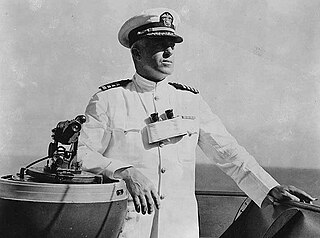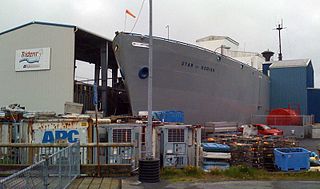
The United States Merchant Marine is an organization composed of United States civilian mariners and U.S. civilian and federally owned merchant vessels. Both the civilian mariners and the merchant vessels are managed by a combination of the government and private sectors, and engage in commerce or transportation of goods and services in and out of the navigable waters of the United States. The Merchant Marine primarily transports domestic and international cargo and passengers during peacetime, and operate and maintain deep-sea merchant ships, tugboats, towboats, ferries, dredges, excursion vessels, charter boats and other waterborne craft on the oceans, the Great Lakes, rivers, canals, harbors, and other waterways. In times of war, the Merchant Marine can be an auxiliary to the United States Navy, and can be called upon to deliver military personnel and materiel for the military.

The United States Merchant Marine Academy is a United States service academy in Kings Point, New York. It trains its midshipmen to serve as officers in the United States Merchant Marine, branches of the United States Armed Forces and the transportation industry. Midshipmen are trained in different fields such as marine engineering, navigation, ship's administration, maritime law, personnel management, international law, customs, and many other subjects important to the task of running a large ship.

The Military Sealift Command (MSC) is an organization that controls the replenishment and military transport ships of the United States Navy. Military Sealift Command has the responsibility for providing sealift and ocean transportation for all US military services as well as for other government agencies. It first came into existence on 9 July 1949 when the Military Sea Transportation Service (MSTS) became solely responsible for the Department of Defense's ocean transport needs. The MSTS was renamed the Military Sealift Command in 1970.

The National Defense Reserve Fleet (NDRF) consists of ships of the United States, mostly merchant vessels, that have been mothballed but can be activated within 20 to 120 days to provide shipping during national military emergencies, or non-military emergencies such as commercial shipping crises.

SS Flickertail State (T-ACS-5) is a crane ship in ready reserve for the United States Navy. She is stationed at Newport News, Virginia and is in ready reserve under the Military Sealift Command (MSC). The ship was named for the state of North Dakota, which is also known as the Flickertail State.

Daniel Judson Callaghan was a United States Navy officer who received the Medal of Honor posthumously for his actions during the Naval Battle of Guadalcanal. In a three-decades-long career, he served his country in two wars. Callaghan served on several ships during his first 20 years of service, including escort duties during World War I, and also filled some shore-based administrative roles. He later came to the attention of President Franklin D. Roosevelt, who appointed Callaghan as his naval aide in 1938. A few years later, he returned to command duties during the early stages of World War II. An enemy shell killed Callaghan on the bridge of his flagship, USS San Francisco, during a surface action against a larger Japanese force off Savo Island. He was the third of five US Navy admirals killed in battle during WWII, including: Isaac C. Kidd ; Norman Scott ; Henry M. Mullinnix ; and Theodore E. Chandler.

William McCombe Callaghan was a United States Navy officer who served as the first captain of the battleship USS Missouri and the inaugural commander of the Military Sea Transportation Service. Through the course of almost 40 years, he served his country in three wars. His naval career began on a destroyer in the final months of World War I. Following command of the destroyer USS Reuben James and logistical work prior to World War II, he took command of Missouri in 1944.

The United States Transportation Command (USTRANSCOM) is one of the eleven unified commands of the United States Department of Defense. In both times of peace and war, USTRANSCOM's role is to provide the Department of Defense with air, land, and sea transportation. USTRANSCOM was founded in 1987 and is based at Scott Air Force Base in Illinois.

SS Albert M. Boe is a Liberty ship laid down on 11 July 1945 at the East Yard of New England Shipbuilding Corporation in Portland, Maine, as a boxed aircraft transport. The ship is notable as the final liberty ship built.
The structure of the United States Navy consists of four main bodies: the Office of the Secretary of the Navy, the Office of the Chief of Naval Operations, the operating forces, and the Shore Establishment.

The Charleston metropolitan area is an urban area centered around Charleston, South Carolina. The U.S. Office of Management and Budget designates the area as the Charleston-North Charleston, SC Metropolitan Statistical Area, a metropolitan statistical area used for statistical purposes only by the United States Census Bureau and other federal agencies. The OMB defines the area as comprising Berkeley, Charleston and Dorchester counties, an area with 799,636 residents in the 2020 census. Principal cities include Charleston, North Charleston, and Summerville. The area is commonly referred to as the Tri-County Area or the Lowcountry, though the latter term has historically referred to South Carolina's southern coast in general.

USNS Shoshone (T-AO-151), later T-AO-151T, was a United States Navy Maumee-class oiler, later transport oiler, in non-commissioned service with the Military Sea Transportation Service (MSTS), later Military Sealift Command, from 1957 until probably the mid-1980s.

The fifth USNS Potomac (T-AO-181) was a United States Navy oiler in non-commissioned service with the Military Sea Transportation Service, later Military Sealift Command, from 1976 to 1983.

The United States Navy (USN) is the maritime service branch of the United States Armed Forces and one of the eight uniformed services of the United States. It is the world's most powerful navy and the largest by tonnage, at 4.5 million tons in 2021 and in 2009 an estimated battle fleet tonnage that exceeded the next 13 navies combined. It has the world's largest aircraft carrier fleet, with 11 in service, 1 undergoing trials, two new carriers under construction, and six other carriers planned as of 2024. With 336,978 personnel on active duty and 101,583 in the Ready Reserve, the U.S. Navy is the third largest of the United States military service branches in terms of personnel. It has 299 deployable combat vessels and about 4,012 operational aircraft as of July 18, 2023.

SS Cape Intrepid was originally laid down in 1975 as SS Arizona a Type C7 ship intended for both commercial or military use. The ship was launched in 1975 and turned over to the Maritime Administration for commercial use and acquired by the Lykes Brothers and named the SS Lipscomb Lykes. On June 8th 1976 she was removed from commercial duty and reacquired by the United States Navy and renamed USNS Jupiter to serve alongside USNS Mercury. On 8 June 1976 she was transferred to Military Sealift Command, and renamed the SS Cape Intrepid. Since then the ship has been active in transport roles including a long term attachment to the 833rd transport regiment. She is currently in reserve status and can be activated if called upon in 5 days as part of the ready reserve fleet. The ship is currently moored in Tacoma, Washington.

Naval Support Activity Charleston, originally designated Naval Weapons Station Charleston, is a base of the United States Navy located on the west bank of the Cooper River, in the cities of Goose Creek and Hanahan South Carolina. The base encompasses more than 17,000 acres (69 km2) of land with 10,000 acres (40 km2) of forest and wetlands, 16-plus miles of waterfront, four deep-water piers, 38.2 miles (61.5 km) of railroad and 292 miles (470 km) of road. The current workforce numbers more than 11,000 with an additional 3,600 people in on-base family housing.

MV Cape Hudson (T-AKR-5066) was originally built as a commercial ship in 1979 and sold to the Wilhelmsen Line with the name Barber Taif. She has two sister ships named MV Cape Henry and MV Cape Horn.

MV Cape Horn (T-AKR-5068) was originally built as a commercial ship in 1979 and sold to the Wilhelmsen Line with the name Barber Tonsberg. She has two sister ships: MV Cape Hudson and MV Cape Henry.

MV Cape Edmont (T-AKR-5069),, was a Cape E-class roll-on/roll-off built in 1971.



















